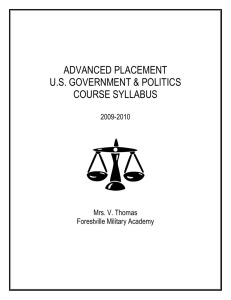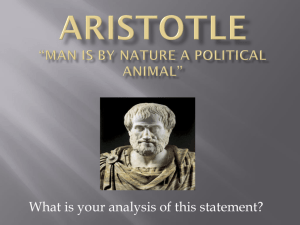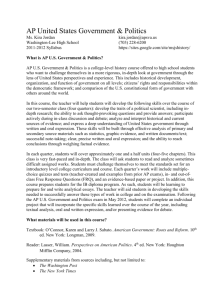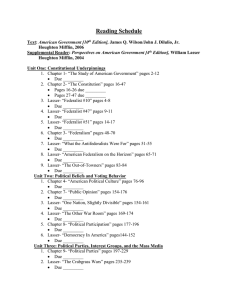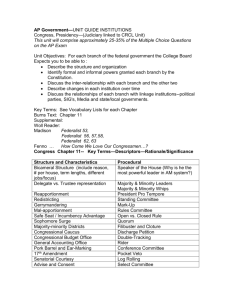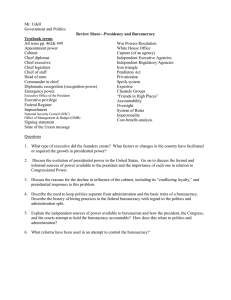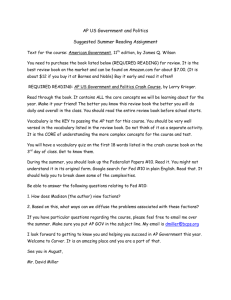AP US Government and Politics Syllabus
advertisement
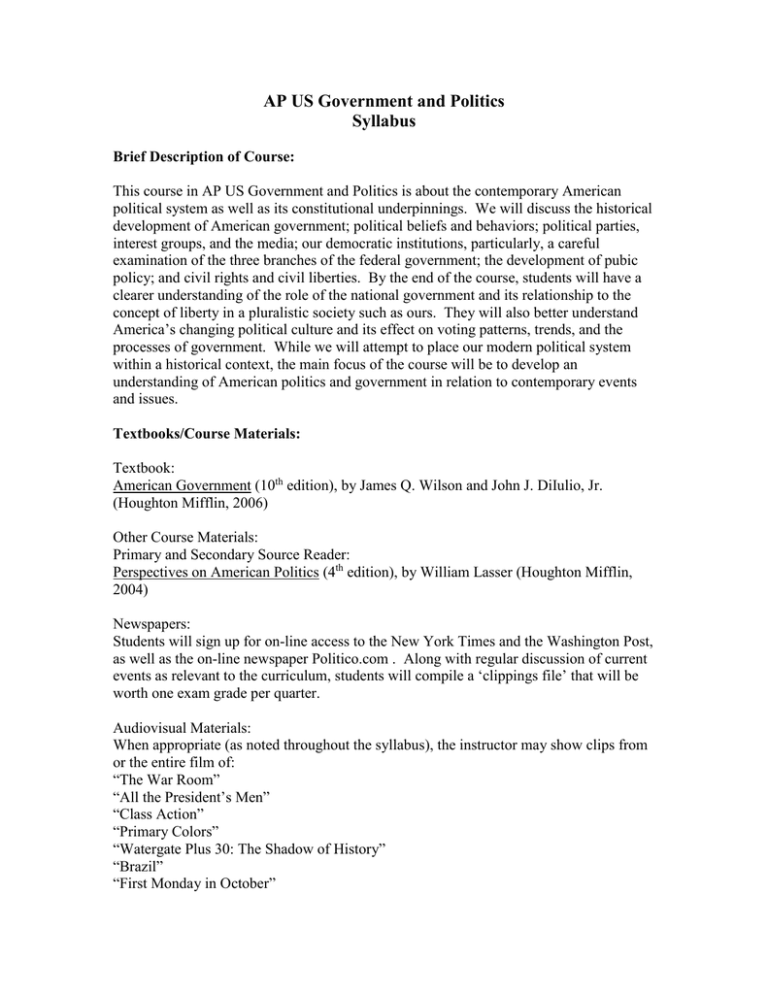
AP US Government and Politics Syllabus Brief Description of Course: This course in AP US Government and Politics is about the contemporary American political system as well as its constitutional underpinnings. We will discuss the historical development of American government; political beliefs and behaviors; political parties, interest groups, and the media; our democratic institutions, particularly, a careful examination of the three branches of the federal government; the development of pubic policy; and civil rights and civil liberties. By the end of the course, students will have a clearer understanding of the role of the national government and its relationship to the concept of liberty in a pluralistic society such as ours. They will also better understand America’s changing political culture and its effect on voting patterns, trends, and the processes of government. While we will attempt to place our modern political system within a historical context, the main focus of the course will be to develop an understanding of American politics and government in relation to contemporary events and issues. Textbooks/Course Materials: Textbook: American Government (10th edition), by James Q. Wilson and John J. DiIulio, Jr. (Houghton Mifflin, 2006) Other Course Materials: Primary and Secondary Source Reader: Perspectives on American Politics (4th edition), by William Lasser (Houghton Mifflin, 2004) Newspapers: Students will sign up for on-line access to the New York Times and the Washington Post, as well as the on-line newspaper Politico.com . Along with regular discussion of current events as relevant to the curriculum, students will compile a ‘clippings file’ that will be worth one exam grade per quarter. Audiovisual Materials: When appropriate (as noted throughout the syllabus), the instructor may show clips from or the entire film of: “The War Room” “All the President’s Men” “Class Action” “Primary Colors” “Watergate Plus 30: The Shadow of History” “Brazil” “First Monday in October” “The Seduction of Joe Tynan” “Down and Out in America” “American Hollow” “Eyes on the Prize” “Ghosts of Mississippi” or other appropriate audiovisual selections. Websites: URL: www.livingroomcandidate/movingimage.us Description: A complete resource on, and archive of, presidential television advertisements since the 1952 campaign, with recent coverage of web advertisements as well. Presented by the American Museum of the Moving Image. URL: www.vote-smart.org Description: Nonpartisan source for policy positions and campaign finance information on candidates and officeholders at the state and federal levels. URL: Various Description: Students will be introduced to political blogs from both ends of the spectrum, such as DailyKos, MyDD, BoomanTribune, and HuffPost on the left and RealClearPolitics, littlegreenfootballs, and instapundit on the right. Note: The course will provide students with practice in analyzing and interpreting data relevant to US government and politics. The course textbook has been chosen in part because of the proliferation of charts, graphs, maps, and other types of quantitative and visually-presented information that it contains throughout every chapter. Students will be instructed in the use of these visual resources and will be tested on them regularly on the chapter quizzes and unit examinations administered throughout the course. Unit Information: Unit One—CONSTITUTIONAL UNDERPINNINGS OF UNITED STATES GOVERNMENT (4 weeks) Reading: Wilson Ch. 1-3 and 22; Lasser Ch. 1 (Federalist #10, Federalist #47, Federalist #48, Federalist #51, the Address and Reasons of Dissent of the Minority of the Convention of Pennsylvania to Their Constituents); Lasser Ch. 2 (What the Anti-Federalists Were For; Federalist #45; American Federalism on the Horizon; The Man Behind the Mayor; The Out-of-Towners) Content/Skills Taught: Students should understand: Reasons for the study of American government; The historical context in which the US Constitution was written; Key principles of the Constitution, including federalism, separation of powers, and checks and balances; The federalist/anti-federalist debates; The history of federal-state relations; Modern federalism, including devolution; and, The grant-in-aid system. Major assignments/assessments: Chapter Quizzes (Wilson Ch. 1/22, 2, 3) Unit Exam (Multiple Choice, Free Response) Unit Two—POLITICAL BELIEFS AND BEHAVIORS (5 weeks) Reading: Wilson Ch. 4, 7, 8, 10; Lasser Ch. 5 (Democracy in America; One Nation, Slightly Divisible; American Exceptionalism; The Other War Room); Lasser Ch. 8 (The Crabgrass Wars; Oh, Waiter! One Order of Crow!) Film: “The War Room” Content/Skills Taught: Students should understand: Characteristics of America’s unique political culture; The historical sources of our political culture; What public opinion is, how it is shaped, and how it is measured; The modern understanding of ‘liberalism’ and ‘conservatism’; The distinctive belief and behavior systems of various groups within American society; Who participates in politics and why; Similarities and differences between presidential and congressional elections; Distinctions between primary and general elections; Sources of and regulations on campaign financing; and, The effects of election results on policy. Major assignments/assessments: Chapter Quizzes (Wilson Ch. 4, 7, 8, 10) Unit Exam (Multiple Choice, Free Response) Unit Three—POLITICAL PARTIES, INTEREST GROUPS, AND MASS MEDIA (5 weeks) Reading: Wilson Ch. 9, 11, 12; Lasser Ch. 8 (Towards a More Responsible Two-Party System; Breaking the Two-Party Monopoly), Lasser Ch. 6 (Always Involved, Rarely Central; A New Form of Lobbying…), Lasser Ch. 7 (New York Times Co. v United States; Bias; Victim Politics; Keeper of Secrets) Films: “All the President’s Men” “Class Action” “Primary Colors” Content/Skills Taught: Students should understand: The history of the American two-party system; The differences between the two-party system and the multi-party system; The differences between single-member plurality elections and proportional representation; The role of minor parties in American politics; The role of primary elections in the presidential nominating process; Reasons for the proliferation of interest groups in the U.S.; Types of interest groups; The activities of interest groups and how they are regulated; The history of journalism in American politics; The rules governing the media; and, The biases reflected in the national media. Major Assignments/Assessments: Chapter Quizzes (Wilson Ch. 9, 11, 12) Unit Exam (Multiple Choice, Free Response) Unit Four—THE INSTITUTIONS OF NATIONAL GOVERNMENT: THE CONGRESS, THE PRESIDENCY, THE BUREAUCRACY, and THE JUDICIARY (9 weeks) Reading: Wilson Ch. 13, 14, 15, 16; Lasser Ch. 9 (Federalist #55, Federalist #57; What the American Public Wants Congress to Be), Lasser Ch. 10 (Federalist #68, Federalist #70; Presidential Power; September 11, 2001), Lasser Ch. 11 (Bureaucracy: What Government Agencies Do and Why They Do It; Descent into Evil), Lasser Ch. 12 (Federalist #78, Marbury v. Madison; Beyond Bush v. Gore; The “Accidental” President) Films: “Watergate Plus 30: The Shadow of History” “Brazil” “First Monday in October” “The Seduction of Joe Tynan” Content/Skills Taught: Students should understand: The differences between Congress and a Parliament; Who is in Congress?; That Congressional actions do not always mirror public opinion; The organization of Congress (Parties and Caucuses, committees, staff); How a Bill Becomes a Law; The differences between a president and a prime minister; The evolution of the presidency; The powers of the president, both official and unofficial; Limits on presidential powers; The history of the federal bureaucracy; Tensions between the bureaucracy and politicians; Congressional oversight of the bureaucracy; The development of the federal courts; The structure of the federal court system (lower courts and Supreme Court): How a case gets to the Supreme Court; How the Supreme Court operates; The debate over Judicial Activism; and, Checks on judicial powers. Major Assignments/Assessments: Chapter Quizzes (Wilson Ch. 13, 14, 15, 16) Unit Exam (Multiple Choice, Two Free Response) Unit Five—THE POLITICS OF PUBLIC POLICY (4 weeks) Reading: Wilson Ch. 17, 18, 19, 20 Lasser Ch. 13 (Domestic Policy Making; Nine Misconceptions about Social Security; America and the World: Taking the Initiative) Films: “Down and Out in America” “American Hollow” Content/Skills Taught: Students should understand: How certain issues at certain times are placed onto the political agenda; The differences between majoritarian, client, interest group, and entrepreneurial politics; The roles of perceptions, beliefs, interests, and values in shaping public policy; How economic policy is developed; The basic differences between Monetary, Keynesian, Planning, and Supply-side economic theories; The history of American welfare policy; Majoritarian welfare programs vs. client welfare programs; The relative powers of the President and Congress in shaping foreign policy; Reasons for the volatility of public opinion on foreign affairs; and, Why the cost-overrun problem is due to bureaucratic and political factors, and the proposed reforms of the system. Major Assignments/Assessments: Chapter Quizzes (Wilson Ch. 17, 18, 19, 20) Unit Exam (Multiple Choice, Free Response) Unit Six—CIVIL LIBERTIES AND CIVIL RIGHTS (4 weeks) Reading: Wilson Ch. 5, 6; Lasser Ch. 3 (On Liberty; Terrorism and the Limits of Law; Speaking Our Minds), Lasser Ch. 4 (Plessy v. Ferguson, Brown v. Board of Education, Bolling v. Sharpe; Affirmative Action—Don’t Mend or End It—Bend It; Women in the Barracks) Films: “Eyes on the Prize” “Ghosts of Mississippi” Content/Skills Taught: Students should understand: The relationship between the Bill of Rights and majority rule; How civil liberties may at times be a matter of majoritarian politics; How the Supreme Court has used the Fourteenth Amendment to expand coverage in the federal system; Changing conceptions of the due process clause of the Fourteenth Amendment; The strategies used by African American leaders during the civil rights movement; The NAACP strategy of litigation from Plessy v. Ferguson to Brown v. Board of Education; The differences between the African American and the women’s movements for civil rights; What is meant by ‘affirmative action’ and the debate surrounding it; and, The current struggle for gay rights and the role of the states in the gay rights movement. Unit Seven—AP EXAM REVIEW (1 week) Content/Skills Taught: Students will prepare for the AP Exam by completing practice exams, reviewing course content material, and working individually and in study groups. Unit Eight—INDEPENDENT RESEARCH (3 weeks) Content/Skills Taught: Working in small groups, students will research a major policy area in American politics today. They will then present a summary of their findings to the class, including an overview of the issue; a summary of the major positions; a list of the important figures or groups who are working on the issue; and a recommended policy position, with justification, from the group. Major Assignment/Assessment: Students will deliver a final presentation that will be a major grade for the fourth quarter.
